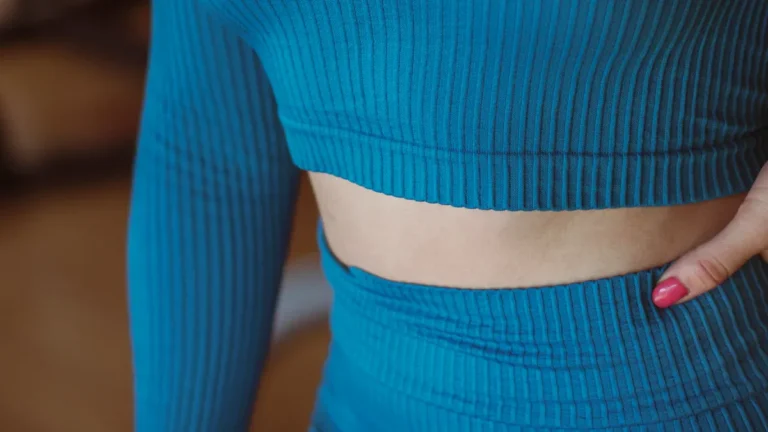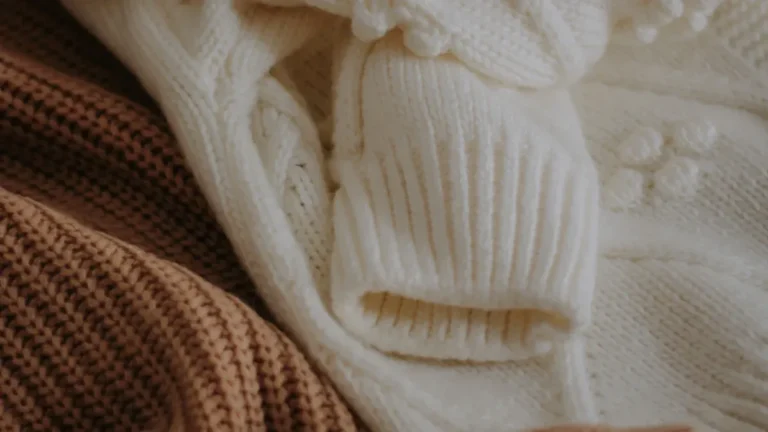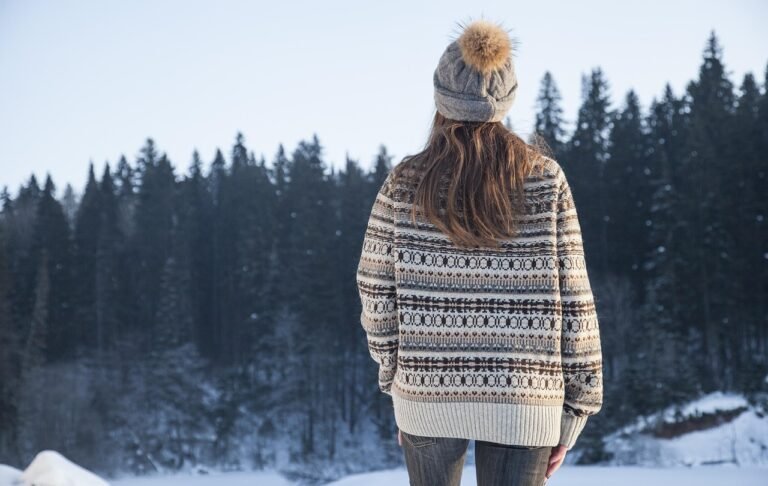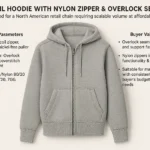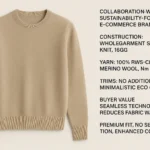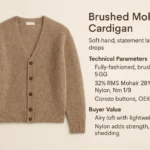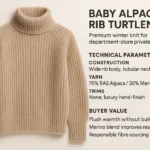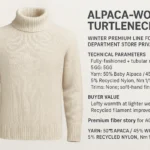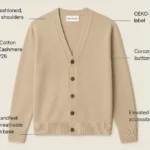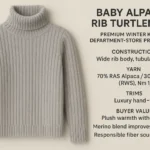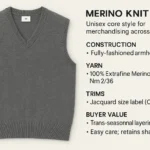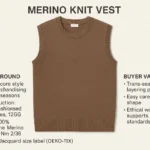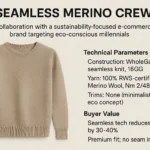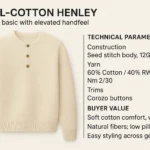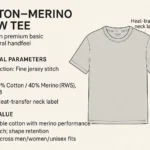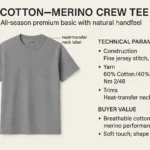
You want cardigans that keep your team comfortable and looking sharp. Wool vs Cotton is a key choice. Wool gives you extra warmth and lasts longer, but needs careful cleaning. Cotton feels lighter, costs less, and handles washing well. Your brand image and employee satisfaction depend on this decision.
Many buyers worry about warmth, maintenance, and cost. You need the right balance for value and style.
Key Takeaways
Wool cardigans keep you warm and last a long time. They are good for cold days and formal events. Cotton cardigans are light and not expensive. They are easy to wash and good for warm weather or casual days. Think about how you will use the cardigans. Pick wool for winter uniforms. Choose cotton for spring or summer clothes. Talk to your OEM manufacturer for help. They can guide you on fiber choices, yarn counts, and how to care for the cardigans. This will help you get what you need. Choose certified materials to help the planet. Use organic cotton or wool that is sourced responsibly. This can make your brand look better.
Material Selection Importance
Fiber Impact
Picking wool or cotton changes how your cardigans feel and look. Wool keeps you warm and lasts a long time. Cotton is lighter and feels soft. Good materials make your team more comfortable. They also help your brand look better. Corporate clothes show off your company everywhere. When workers wear nice cardigans, your brand stands out. People can tell when you use good fibers. Using eco-friendly wool or cotton is important too. It shows you care about the planet. This helps customers trust your company and want to come back.
Tip: Good fibers help cardigans last longer and look nice, which is good for your brand.
Manufacturer Guidance
You do not have to pick alone. OEM manufacturers help you choose the best yarn. They know which fibers work for each style. You can ask them about yarn counts and blends. They help you find what fits your budget and goals. Many give samples so you can check the feel. You get advice on how to care for the cardigans. This help saves you money and gives you the best value.
Ask your manufacturer:
Which fiber works for your weather?
What yarn count fits best?
How does each material change care and how long it lasts?
End-Use Match
Think about how people will wear your cardigans. Wool or cotton matters for uniforms, stores, and seasons. Wool is good for winter and formal clothes. Cotton is better for casual and warm weather. If you want easy care and lower price, pick cotton. Wool looks fancy and keeps you warm. Pick the right fiber so your team is comfy and your brand looks great.
Use Case | Wool Cardigan | Cotton Cardigan |
|---|---|---|
Winter Uniforms | ✅ | ❌ |
Casual Retail | ❌ | ✅ |
Easy Care | ❌ | ✅ |
Premium Image | ✅ | ❌ |
Wool vs Cotton: Technical Comparison

Warmth & Breathability
When you compare wool and cotton cardigans, you notice big differences in warmth. Wool fibers have a natural crimp. This crimp creates tiny air pockets that trap heat, much like a thermal blanket. Wool cardigans keep you warm even when the weather turns cold. Cotton cardigans feel cooler. Cotton lets air move through the fabric, so you do not get too hot. If you wear a cotton cardigan on a chilly day, you may feel cold, especially if the fabric gets damp. Wool keeps its warmth, but cotton loses heat when wet.
Tip: Wool works best for winter or cold offices. Cotton is better for mild or warm days.
Cotton cardigans shine in breathability. You can wear them in warm weather and stay comfortable. Cotton absorbs sweat and lets it evaporate, so you do not feel sticky. Wool cardigans feel cozy, but they may trap heat in humid conditions. If you want a cardigan for sunny days or indoor use, cotton is a smart choice.
Comfort Differences
You want your team to feel good all day. Wool cardigans give warmth and insulation, so they work well in cold places. Some people find wool a bit scratchy, especially if they have sensitive skin. Merino wool feels softer, but regular wool may itch. Cotton cardigans feel soft and gentle. You can wear them for hours in an office or store. Cotton does not irritate most skin types. If you want comfort for everyone, cotton is a safe pick.
Wool cardigans: Best for warmth, but may itch.
Cotton cardigans: Soft, light, and easy to wear indoors.
Cost & MOQ
Cost matters when you buy for a whole team. Wool cardigans usually cost more than cotton ones. Wool is a premium fiber, and it takes more care to make and clean. Cotton cardigans cost less and are easier to wash. If you want to save money, cotton is the budget-friendly option.
When you order from an OEM factory, you need to think about minimum order quantity (MOQ). Many factories start at 100 pieces per design for custom cardigans. Some offer lower MOQs, like 20 pieces, for special orders. If you plan a big order, factories can make over 50,000 units each month. The MOQ may change if you pick a rare yarn or a complex design.
Note: Ask your supplier about MOQ before you choose wool or cotton. Cotton is often easier to source in small batches.
Sustainability
You may want to choose cardigans that help the planet. Wool is a natural, renewable fiber. Sheep grow new wool every year. Wool breaks down in the soil and does not pollute. Cotton is also natural, but it needs a lot of water to grow. Some cotton farms use chemicals, but you can ask for organic cotton. Both wool and cotton can be traced back to their source. Many brands now use certified wool or cotton to show they care about the environment.
Wool: Renewable, biodegradable, but needs careful washing.
Cotton: Natural, can be organic, but uses more water.
Yarn Counts & Gauges
You need to know about yarn counts and gauges when you order cardigans. Yarn count tells you how thick or thin the yarn is. A higher count means a finer yarn. Gauge means how many stitches fit in one inch of fabric. A higher gauge gives a finer, lighter cardigan. Wool cardigans often use medium to high yarn counts for warmth. Cotton cardigans use a range of counts, from chunky to fine.
Fiber | Common Yarn Counts | Typical Gauges | Best Use |
|---|---|---|---|
Wool | 26s/2, 48s/2 | 7, 12, 14 | Winter, formal, premium |
Cotton | 32s/2, 40s/2 | 12, 14, 16 | Spring, summer, casual |
If you want a lightweight cardigan, ask for a higher gauge and finer yarn. For a chunky, warm style, pick a lower gauge.
Wool vs Cotton cardigans each have strengths. Wool keeps you warm and lasts longer, but costs more and needs special care. Cotton feels light, costs less, and is easy to wash. You can match the yarn count and gauge to your needs, whether you want a thick winter cardigan or a light summer layer.
Wool Cardigan Insights
Wool Types
There are many kinds of wool for cardigans. Merino wool feels soft and smooth. It keeps you warm but is not heavy. Lambswool is gentle and stretches easily. It lets your skin breathe and stays comfy all day. Mohair wool is shiny and keeps its shape well. Shetland wool is warm and looks rustic. Each kind fits a different style or use.
Properties | Uses in Corporate Cardigans | |
|---|---|---|
Mohair Wool | Lustrous sheen, exceptional durability, resilient, holds shape | Excellent for structured garments |
Shetland Wool | Warmth, durability, rustic charm, wide range of natural colors | Ideal for traditional and outdoor styles |
Lambswool | Incredibly soft, fine, natural elasticity, breathable | Popular for comfortable and durable cardigans |
Blends mix wool with other fibers for extra softness or strength. Some blends use acrylic or nylon to save money and make care easier.
Processing Methods
You can pick how your wool cardigans are made. Full-fashioned cardigans use special machines to shape each piece. This gives a neat look and less waste. Cut & sewn cardigans use flat fabric. Workers cut shapes and sew them together. This way is good for simple designs and saves time.
Finishing Techniques
You want cardigans that last and look nice. Makers use special finishes to help.
Washing and blocking keep the shape and size even.
Wet blocking uses warm water and wool wash for softness.
Pinning during blocking stops the edges from curling.
Anti-pilling finishes help cardigans stay smooth.
Shrink-resistant treatments keep the fit right after washing.
Tip: Ask your supplier about these finishes so cardigans stay new longer.
Corporate Preference
Many companies choose wool for winter uniforms and premium lines. Wool looks professional and feels warm. You show your team you care about comfort and style. Wool vs Cotton is a common question for buyers. Wool is best for warmth and a fancy look. You get a cardigan that stands out at meetings and events.
Cotton Cardigan Capabilities
Yarn Types
You can choose from different cotton yarns for your cardigans. Ring-spun cotton yarn feels soft and strong. It comes from twisting and thinning the cotton strands. Combed cotton yarn goes through an extra step. Workers remove short fibers and impurities. This makes the yarn smoother and less likely to pill. Both yarns give you comfort and durability. Cotton yarn stands up to regular wear and resists fraying. It feels gentle against the skin and lets air flow.
Yarn Type | Durability | Comfort |
|---|---|---|
Wool | Highly resilient, withstands over 20,000 bends | Maintains shape, suitable for stylish items |
Cotton | Strong, withstands regular wear, resistant to fraying | Soft, breathable, gentle against the skin |
Tip: Choose combed cotton for a smoother, softer finish in premium cardigans.
Surface Finishing
Surface finishing changes how your cotton cardigans look and last. Mercerization gives cotton a shiny, bright look. It makes the fibers stronger and helps them hold dye better. This process swells the fibers, so they reflect more light and feel smoother. Enzyme washing uses natural enzymes to clean the fabric. This method is gentle on the environment and helps your cardigans stay soft and last longer.
Cotton Blends
You can blend cotton with other fibers to get special features. Cotton-acrylic blends add stretch and help the cardigan keep its shape. Cotton-polyester blends dry faster and resist wrinkles. Cotton-nylon blends make the fabric stronger and lighter. These blends help you meet different needs for your team or customers.
Gauge Options
Gauge tells you how thick or thin your cardigan will be. A high gauge means a fine, lightweight knit. A low gauge gives you a chunky, warm feel. Cotton cardigans come in many gauges. You can pick a fine gauge for a dressy look or a chunky gauge for a cozy style.
Retail & Seasonal Use
Cotton cardigans work well for retail and changing seasons. You can wear them in spring, summer, or fall. They feel cool and comfortable indoors or outside. Many stores pick cotton cardigans for their easy care and wide appeal. You get a product that fits many styles and keeps your team or customers happy.
Note: Cotton cardigans offer flexibility for both casual and professional settings. You can match them to your brand’s needs all year round.
Specialty Fibers
Cashmere
You may want to choose cashmere if you need luxury and warmth. Cashmere comes from the soft undercoat of cashmere goats. This fiber feels very soft and keeps you warm in cold weather. Many people like cashmere because it feels light but insulates well. You will notice that cashmere cardigans look elegant and feel gentle on the skin. Cashmere costs more than other fibers. You pay for the comfort and status it brings to your team’s wardrobe.
Alpaca
Alpaca fiber gives you a unique mix of warmth and breathability. Alpaca cardigans wick away moisture and let your skin breathe. You can wear alpaca in both cool and mild weather. Alpaca fibers feel soft and do not itch like some wool. These cardigans last a long time because alpaca is highly durable. You get a cardigan that keeps its shape and looks new after many wears.
Tip: Alpaca cardigans work well for teams who need comfort and long-lasting style.
Linen
Linen comes from the flax plant. You get a fabric that feels cool and crisp. Linen cardigans suit warm climates and summer uniforms. Linen does not trap heat, so you stay comfortable indoors and outdoors. This fiber dries quickly and resists static. Linen wrinkles more than other fibers, but it gives a relaxed, natural look.
Rayon & Viscose
Rayon and viscose are man-made fibers from plant sources. You get a smooth, silky feel at a lower cost than silk. These fibers drape well and add shine to cardigans. Rayon and viscose cardigans feel lightweight and cool. They work best for spring and summer collections. You can blend them with cotton or wool for extra softness.
Fiber Blends
You can choose blends to get the best features of each fiber. Cotton-wool blends give you warmth and insulation for cold days. These blends keep the breathability of cotton, so you do not overheat. Wool’s moisture-wicking keeps you dry, while cotton adds softness and reduces itchiness. Wool-nylon blends add strength and help your cardigan last longer. Nylon helps the cardigan keep its shape and makes it a smart choice for daily wear.
Material | Warmth | Durability |
|---|---|---|
Cashmere | Very warm | Moderate |
Alpaca | Breathable, moisture-wicking | Highly durable |
Linen | Cool, not warm | Moderate |
Rayon | Lightweight | Moderate |
Note: Specialty fibers and blends help you match cardigans to your brand’s needs, from luxury to everyday comfort.
Knit Structure & Texture

Ribbed Techniques
You see ribbed knits in many corporate cardigans. Rib knits use alternating knit and purl stitches. This creates vertical ridges that run down the fabric. Ribbed cardigans stretch easily and snap back into shape. You get a snug fit that feels comfortable all day. The fabric stays stable and does not lose its shape after washing. Ribbed cuffs and hems help cardigans look neat and professional.
Tip: Ribbed knits work well for uniforms because they fit many body types and keep their form.
Jacquard Patterns
Jacquard patterns add style to your cardigans. You notice these patterns because they use different colors and stitches to create designs. Jacquard knits can show your company logo or brand colors. The fabric feels thicker and sometimes heavier. You get a cardigan that stands out and looks unique. Jacquard blends may develop fuzz or snags over time, so you need to check the quality before you buy.
Chunky Styles
Chunky cardigans use thick yarns and low gauge. You see these styles in winter collections. Chunky knits feel warm and cozy. The fabric looks bold and has a three-dimensional texture. Heavier knits mean stronger cardigans. Tight weaves help prevent snags and stretching. You get a durable garment that keeps your team warm in cold offices or outdoor events.
Fine Gauge
Fine gauge cardigans use thin yarns and high stitch counts. You notice these styles in dressy or lightweight collections. Fine gauge knits feel smooth and soft against the skin. The fabric looks sleek and fits well under jackets. You get a cardigan that works for formal meetings or warm climates. Fine gauge knits show off the quality of the yarn and the skill of the maker.
Stitch Density
Stitch density affects how your cardigan looks and lasts. Wool cardigans benefit from tight fiber cohesion. Wool’s natural lanolin helps reduce pilling and keeps fibers strong. Tighter knits make cardigans more durable and less likely to snag. Looser knits may stretch or wear out faster. Heavier knits mean stronger garments. You should choose the right stitch density for your needs.
Wool cardigans: Tight weaves, less pilling, more durability.
Cotton cardigans: Looser knits, softer feel, may stretch over time.
Note: Stitch density helps you balance comfort, durability, and appearance in every cardigan you order.
Production Workflow
Yarn Sourcing
You start with yarn sourcing. You choose the right fiber for your cardigans. Factories inspect the yarn for quality. Workers store the yarn in clean, dry rooms. Good yarn gives you strong, soft cardigans. You can ask for wool, cotton, or blends. Factories wind the yarn and prepare it for knitting.
Panel Knitting
Panel knitting shapes the cardigan pieces. Machines knit the front, back, and sleeves as separate panels. Workers check the panels for mistakes. You see online inspection during knitting. This step helps catch problems early. After knitting, workers link the panels together. Hand stitching and over-locking make the seams strong.
Tip: Panel knitting lets you customize the fit and style for your team.
Testing
Testing makes sure your cardigans meet standards. Factories run shrinkage tests to check if the fabric keeps its size. Colorfastness tests show if the color stays bright after washing. Durability tests measure how well the cardigan stands up to wear. Workers inspect the fabric and check the fit. You get cardigans that look good and last longer.
MOQ & Sampling
You need to know the minimum order quantity (MOQ). Factories often set MOQ at 100 pieces per design. Some offer samples before full production. Sampling lets you check the yarn, fit, and finish. You can ask for changes before placing a big order. Sampling helps you avoid mistakes and get the best value.
Quality Control
Quality control keeps your cardigans consistent. Factories use many checks for wool and cotton. You see shrinkage, colorfastness, durability, and visual inspections. Workers test the fabric and check the fit. The table below shows common quality control measures for both fibers:
Quality Control Measure | Wool | Cotton |
|---|---|---|
Shrinkage Test | Yes | Yes |
Colorfastness Test | Yes | Yes |
Durability Test | Yes | Yes |
Visual Inspection | Yes | Yes |
Fabric Testing | Yes | Yes |
Garment Fit Testing | Yes | Yes |
Note: Strong quality control means you get cardigans that match your brand’s standards every time.
Case Study
Buyer Profile
You work for a Scandinavian retail chain. Your stores focus on modern, clean designs. You want cardigans that fit your brand’s image. Your customers expect quality and comfort. You need a product that works for both cool summers and cold winters. You also care about sustainability and want to show your commitment to the environment.
Yarn & Stitch Choice
You choose Merino wool for winter cardigans. Merino feels soft and keeps warmth in. For spring and fall, you pick combed cotton. Cotton gives a light, breathable feel. You ask for a fine gauge knit for a smooth look. You want ribbed cuffs and hems for a neat finish. Your supplier suggests a 14-gauge for cotton and a 12-gauge for wool. This gives you the right balance of comfort and durability.
Season | Yarn Type | Gauge | Key Feature |
|---|---|---|---|
Winter | Merino Wool | 12 | Warmth |
Spring/Fall | Combed Cotton | 14 | Breathability |
Sampling & QC
You request samples before placing a large order. You check the color, fit, and softness. You test the cardigans for shrinkage and pilling. Your team wears the samples in-store to see how they hold up. You give feedback to the factory. The factory makes small changes to improve the fit and feel. You approve the final sample before production starts.
Tip: Always test samples in real conditions. This helps you find problems early.
Packaging & Delivery
You want packaging that matches your brand. You choose recycled boxes and simple labels. The factory packs each cardigan in a polybag to keep it clean. You ask for clear size labels. The factory ships the cardigans by sea to reduce your carbon footprint. You track the shipment online.
Lessons Learned
You learn that clear communication with your supplier saves time. You see that testing samples prevents costly mistakes. You find that choosing the right yarn and gauge makes a big difference in comfort and durability. You discover that eco-friendly packaging impresses your customers. You can use these lessons for future orders.
Note: Good planning and teamwork with your supplier lead to better products and happier customers.
Compliance & Sustainability
Certifications
You want your cardigans to be safe and good for the planet. Certifications help you check if your wool and cotton are from trusted places. The Responsible Wool Standard (RWS) has rules for how sheep are treated and how land is cared for. Farms must treat sheep kindly and avoid bad actions. RWS also follows the wool from the farm to the factory, so you know where it comes from. Other certifications, like Regenagri and the Soil Association, focus on organic and earth-friendly farming. These programs protect the soil and make sure workers are treated fairly.
Certification Name | Purpose | Required Certification Level |
|---|---|---|
Responsible Wool Standard (RWS) | Makes sure sheep are treated well and land is cared for. | Needs 100% RWS wool; follows animal care rules. |
Regenagri | Checks that materials come from farms using good growing methods. | At least half of the fiber must be from certified regenerative sources. |
Soil Association Certification | Supports organic farming all along the supply chain. | Factories must get GOTS certification to keep organic rules. |
Regenerative Cotton Standard (RCS) | Helps small cotton farms grow better and stronger crops. | Farms must have a plan to keep improving and get checked often. |
IVN Best Naturtextil | Needs all materials to be organic and made in a green way. | Covers every step of making clothes, with low harm to nature and fair work. |
Tip: Always ask your supplier for proof of certifications before you buy. This shows you care about the planet.
Sustainable Yarns
You can pick yarns that are good for the earth and your company’s image. Organic cotton feels soft and lets skin breathe. It breaks down in nature and uses fewer chemicals. Alpaca yarn is warm and comfy, and comes from animals treated well. Linen yarn is strong and cool, great for hot days. Blended yarns mix fibers to get the best mix of softness and strength.
Yarn Type | Pros | Cons | Best Uses |
|---|---|---|---|
Organic Cotton | Soft, lets skin breathe, breaks down easily | Can cost more | Cardigans, light clothes |
Alpaca | Very soft, warm, and earth-friendly | May stretch out over time | Scarves, wraps, warm sweaters |
Linen | Strong, cool, gets softer with use | Feels stiff at first | Summer tops, shawls, light cardigans |
Blended Yarns | Mixes the best parts of each fiber | Changes by blend | Many uses, depends on the blend |
Waste Management
You can cut down on waste by picking factories that recycle scraps and use green packaging. Many suppliers now reuse leftover yarn and fabric. Some turn waste into new things, like cleaning rags or insulation. You can ask for boxes and bags made from recycled stuff. This helps the planet and shows your customers you care.
Pick factories that recycle yarn and fabric leftovers.
Ask for packaging made from recycled things.
Support suppliers who save water and energy.
Supply Chain Transparency
You should know where your cardigans come from. Supply chain transparency means you can follow each step, from farm to store. Certified suppliers share where they get their materials and how they make products. You can ask for reports or even visit the factories. This helps you spot problems and make smart choices. Customers trust brands that share these details.
Note: Keeping clear records of your supply chain helps you meet world standards and earn trust from buyers and users.
Work with a Multi-Fiber OEM Cardigan Factory
Why Choose a Supplier Experienced in Wool, Cotton & Cashmere
You want a supplier who knows many fibers. This helps you get the best cardigans for your team or store. A multi-fiber OEM factory gives you more choices and better results. You can see the main advantages in the table below:
Advantage | Description |
|---|---|
Integrated Operations | You get smooth service from design to delivery. |
Flexible MOQs | You can order small batches or large quantities, starting at 200 units. |
Sustainable Practices | You can choose eco-friendly materials like organic cotton and Lyocell. |
Global Reach | You receive your cardigans on time in North America, Europe, and other regions. |
Proven Track Record | You work with experts who have served thousands of brands for over twenty years. |
Tip: A supplier with experience in wool, cotton, and cashmere helps you match your needs for every season and style.
Custom Sampling and Logo Embroidery Options
You can ask for custom samples before you order a lot. This lets you check the color, fit, and feel. The factory makes samples quickly and checks quality closely. You can pick from more than ten colors and use eco-friendly yarns. You can add your logo to pockets, sleeves, chests, or backs. You can pick men’s or women’s cuts. You can also choose branded tags for a special touch.
Put your logo on the front, back, sleeves, or hem
Pick many colors for your brand
Choose branded tags and decorations
Feature | Details |
|---|---|
$26.16 | |
Sample time | 15 Days |
Regular price | |
7 Days Sample Lead Time | Supported |
Lead Times and Quality Guarantees for International Buyers
You need your cardigans delivered on time. The factory makes samples fast and produces in bulk. You get clear timelines for each step. Quality checks make sure every cardigan meets your standards. You can trust the supplier to ship to North America, Europe, and other places. You get updates on your order and help if you have questions.
Note: Reliable lead times and strong quality checks help you plan your inventory and avoid delays.
Start Your OEM Cardigan Development Project with AZKnit
You can start your project with AZKnit by sharing your ideas and needs. The team helps you pick fibers, colors, and designs. You get samples to test before full production. You can add custom logos and tags to match your brand. AZKnit guides you through every step, from yarn selection to delivery. You get expert help and high-quality cardigans for your team or store.
Share your design ideas
Pick fibers and colors
Test samples before production
Add custom logos and tags
Get help from start to finish
Tip: Working with AZKnit makes your cardigan project easy and successful.
Sourcing Tips
Yarn Specs
You need to know the yarn specs before you order cardigans. Yarn specs tell you the thickness, softness, and strength of the fiber. You can ask for details like yarn count, ply, and fiber blend. These specs affect how the cardigan feels and lasts. If you want a soft cardigan, choose a fine yarn count. For a chunky style, pick a lower count. You can use the table below to compare common specs:
Yarn Spec | What It Means | Best For |
|---|---|---|
32s/2 Cotton | Fine, soft, smooth | Lightweight styles |
26s/2 Wool | Medium, warm, strong | Winter wear |
Blended Yarn | Mixed fibers | Durability, comfort |
Tip: Always ask your supplier for yarn samples before you decide.
Factory Expertise
You should check the factory’s expertise before you place an order. Experienced factories know how to handle different fibers. They use good machines and skilled workers. You can ask for photos of their work or visit the factory. Factories with strong expertise make cardigans that fit well and last longer. You can look for factories with certifications and a history of working with big brands.
Ask for factory certifications
Request references from other buyers
Check sample quality
Negotiating MOQ
You need to understand MOQ, or minimum order quantity. Factories set MOQ to manage costs and production. You can negotiate MOQ if you want a small batch or a test run. Some factories offer flexible MOQ for new buyers. You can ask for a lower MOQ if you use standard yarns or simple designs. If you order more, you may get a better price.
Note: Always discuss MOQ early to avoid surprises.
Supplier Relationships
You should build strong relationships with your suppliers. Good relationships help you get better service and faster answers. You can keep in touch by email or video calls. You can share feedback and ask for changes. Suppliers who trust you may offer better prices and faster delivery. You can visit the factory or invite the supplier to your office.
Communicate clearly and often
Give feedback on samples
Build trust for long-term success
Tip: Strong supplier relationships lead to better cardigans and smoother orders.
You need to pick the best cardigan for your team. Choosing between wool and cotton is important. Wool keeps you warm and looks fancy. It also helps block water. Cotton feels soft and is easy to wash. Cotton costs less than wool. Think about how your team will use the cardigans. Wool is good for cold weather and dressy uniforms. Cotton works for casual jobs and hot days. Ask your OEM manufacturer for advice on what fits best.
Wool | Cotton | |
|---|---|---|
Warmth | High | Moderate |
Care | Needs attention | Easy |
Cost | Higher | Lower |
Appearance | Professional, formal | Casual, versatile |
Tip: Think about comfort, how long it lasts, and how to clean it before you decide.
FAQ
What makes wool cardigans better for cold offices?
Wool holds heat because of its special shape. You feel warm even when it gets cold. Wool also blocks wind and helps you stay comfy in winter.
Can you machine wash cotton cardigans?
Most cotton cardigans can go in the washing machine. Use cold water and a gentle wash. Cotton does well with regular washing and keeps its shape after many washes.
How do you choose the right gauge for your brand?
Pick a high gauge if you want a smooth, light look. Choose a low gauge for thick, warm cardigans. Ask your supplier for samples to see which one matches your brand.
Are blended fibers a good choice for uniforms?
Blended fibers mix the best parts of each material. You get stronger cardigans, easier care, and more comfort. Many brands pick blends for uniforms to save money and get good results.
Which fiber is more eco-friendly?
Wool grows back and breaks down in nature. Organic cotton uses less water and fewer chemicals. Both can be good for the planet if you pick certified sources.




